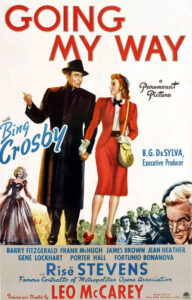Going My Way (1944)
Film and Plot Synopsis
“Going My Way” is a classic American film directed by Leo McCarey and released in 1944. Set in a vibrant parish in New York City, the movie follows the heartwarming journey of Father Chuck O’Malley, a young and unconventional priest who brings a fresh perspective to St. Dominic’s Church. Through his unorthodox methods and genuine compassion, Father O’Malley strives to uplift the spirits of both the parishioners and the troubled youths in the neighborhood.
‘Going My Way’ Movie Summary
 The story begins with the arrival of Father Charles “Chuck” O’Malley (Bing Crosby) to St. Dominic’s Church in New York City. St. Dominic is facing many difficult financial situations that the current priest, the aging and traditional Father Fitzgibbon (Barry Fitzgerald), no longer appears to be capable of dealing with. Father O’Malley has been transferred to the church by the Bishop, although Father Fitzgibbon believes he has been sent there as his assistant. Father O’Malley’s laid-back demeanor and modern approach to religion initially clash with Father Fitzgibbon’s conservative ways. Father Fitzgibbon eventually learns of Father O’Malley’s true purpose at the church and accepts his new role. Over time, the two men develop a deep mutual respect and friendship. During one conversation, Father Fitzgibbon shares his long put off desire to return to Ireland to see his mother, now over 90 years old, whom he has not seen in nearly 45 years. Father O’Malley puts Father Fitzgibbons to sleep that night by singing the Irish lullaby “Too-Ra-Loo-Ra-Loo-Ral.”
The story begins with the arrival of Father Charles “Chuck” O’Malley (Bing Crosby) to St. Dominic’s Church in New York City. St. Dominic is facing many difficult financial situations that the current priest, the aging and traditional Father Fitzgibbon (Barry Fitzgerald), no longer appears to be capable of dealing with. Father O’Malley has been transferred to the church by the Bishop, although Father Fitzgibbon believes he has been sent there as his assistant. Father O’Malley’s laid-back demeanor and modern approach to religion initially clash with Father Fitzgibbon’s conservative ways. Father Fitzgibbon eventually learns of Father O’Malley’s true purpose at the church and accepts his new role. Over time, the two men develop a deep mutual respect and friendship. During one conversation, Father Fitzgibbon shares his long put off desire to return to Ireland to see his mother, now over 90 years old, whom he has not seen in nearly 45 years. Father O’Malley puts Father Fitzgibbons to sleep that night by singing the Irish lullaby “Too-Ra-Loo-Ra-Loo-Ral.”
As Father O’Malley settles into his new role, he encounters various challenges within the parish. One of the primary concerns is the church’s financial struggles, exacerbated by looming foreclosure due to unpaid debts. Determined to find a solution, Father O’Malley employs his resourcefulness and charisma to rally the community together in support of the church. Through his efforts, he manages to organize a successful fundraising concert featuring his own musical talents, drawing significant attention and donations from the locals. Father O’Malley also sells the rights to one of his original musical compositions to a local record producer with all the money going to the church.
Meanwhile, Father O’Malley takes a particular interest in the troubled youth of the neighborhood, especially a group of delinquent boys led by the streetwise tough, Tony Scaponi (Stanley Clements). Rather than resorting to harsh discipline, Father O’Malley adopts a compassionate and understanding approach towards the boys, offering them guidance and mentorship. He encourages their musical talents, forming a choir within the church and giving them a sense of purpose and belonging.
A golf course is nothing but a poolroom moved outdoors. Father Fitzgibbon (Barry Fitzgerald)
Throughout the film, Father O’Malley’s interactions with various members of the parish reveal his profound impact on their lives. One such person is Carol James (Jean Heather), a young girl who has run away from home to avoid her strict parents. After living on her own for a while, Carol begins living with Ted Haines Jr. (James Brown), the son of the church’s mortgage holder, Ted Haines Sr. (Gene Lockhart). Father O’Malley believes that they are living in sin and pays them a visit. Father O’Malley describes to the young couple his calling in life, to follow the joyous side of religion and lead others to do the same, sung as his original composition “Going My Way.” When Ted is confronted by his father about his life choices several weeks later, the elder Haines discovers that Father O’Malley’s words have made an impact with the couple as Ted Jr. and Carole are married and Ted Jr. joined the Air Force.
With St. Dominic’s financial troubles resolved, Father O’Malley is notified that he will be reassigned. As a result, Father Fitzgibbon will be restored to leadership of the church with Father O’Malley’s close friend, Father Timothy O’Dowd (Frank McHugh) tasked with being Fitzgibbon’s assistant. However, the church is damaged by a massive fire. Father Fitzgibbon is devastated at the loss of the church that he helped build. Eventually, reconstruction commences with the church nearly completed by Christmas Eve. The parishioners gather in a temporary church for Mass that also serves as Father O’Malley’s farewell. Unbeknownst to Father Fitzgibbon, Father O’Malley brings the elder priest’s mother (Adeline De Walt Reynolds) from Ireland as a parting gesture of friendship. As mother and son embrace for the first time in 45 years, the boys’ choir sings “Too-Ra-Loo-Ra-Loo-Ral.” Father O’Malley quietly slips away into the night as he embarks on his next journey. Father O’Malley carries with him the cherished memories and enduring bonds forged during his time at the parish, symbolizing the transformative impact of faith and goodwill in the face of adversity.
Rate the Film!
Our Rating
Paramount Pictures released Going My Way on May 29, 1944. Leo McCarey directed the film starring Bing Crosby, Barry Fitzgerald, and Frank McHugh.
